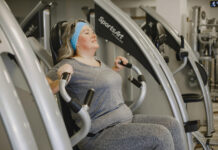The Problem With Fitness Myths
Let’s face it—fitness is confusing. With every scroll on social media, you’re bombarded with fitness “advice,” most of which is outdated, oversimplified, or just plain wrong. These myths don’t just waste your time; they hold you back from real progress.
Why 2025 Is the Time to Get Real
It’s 2025. We’ve got wearables tracking every heartbeat, science-backed training apps, and more research than ever before. There’s no excuse to be stuck believing myths from a decade ago. It’s time to trade misinformation for fitness facts vs myths, and embrace health and fitness truths that actually work.
Common Fitness Myths Debunked
Myth #1: “You Can Spot-Reduce Fat”
Sorry, but doing 100 crunches won’t magically melt belly fat. Fat loss doesn’t work like a sniper rifle—it’s more like a shotgun. Your body decides where fat comes off first, not your workout.
Myth #2: “Cardio Is the Only Way to Lose Weight”
Cardio burns calories, sure. But strength training builds muscle, which increases your resting metabolism. The combo? A lean, efficient calorie-burning machine.
Myth #3: “Lifting Weights Makes You Bulky”
This one needs to die already. Building bulky muscle takes years, a strict diet, and often… enhanced help. For most people, lifting weights results in a toned, lean physique.
Myth #4: “No Pain, No Gain”
Pain isn’t a badge of honor—it’s a warning sign. Progress doesn’t need to hurt. Discomfort? Yes. Sharp pain? Stop immediately.
Myth #5: “Sweating Means You’re Burning More Calories”
Sweat is your body cooling itself, not a calorie calculator. You can sweat in a sauna without moving a muscle. Don’t let sweat fool you.
Myth #6: “More Exercise Equals Better Results”
More isn’t always better. Sometimes it’s just… more. Overtraining can lead to burnout, injury, and hormonal imbalances. Quality over quantity.
Myth #7: “You Need Supplements to See Progress”
Supplements are exactly what they sound like—supplements. Not necessities. Food > pills. Always.
Myth #8: “You Should Work Out Every Day”
Your body needs time to repair and grow. Without rest, you’re just tearing yourself down.
Myth #9: “If You’re Not Sore, You Didn’t Work Hard Enough”
Soreness means your muscles did something new, not necessarily something better. It’s not a scoreboard.
Myth #10: “Crunches Will Get You Abs”
Abs are made in the kitchen. No matter how many crunches you do, if your diet is trash, those abs will stay hidden.
Exercise Facts vs Myths
Understanding Fat Loss vs Muscle Gain
You can lose fat and gain muscle, but they’re two different processes. Fat loss requires a calorie deficit. Muscle gain requires progressive overload and a sufficient intake of protein. Trying to do both at once? Tough—but doable with smart planning.
The Science of Effective Workouts
The best workout isn’t the trendiest—it’s the one you stick to. Science supports compound movements, progressive overload, and consistent routines.
The Importance of Rest and Recovery
Rest is when your body adapts. Skipping recovery is like baking a cake and pulling it out of the oven halfway. You’ll never get the result you want.
Health and Fitness Truths You Should Embrace
Consistency Beats Intensity
You don’t need to kill yourself in every workout. Show up consistently, move with intention, and the results will follow.
Nutrition Is More Than Half the Battle
Exercise might shape your body, but food fuels it. You can’t out-train a bad diet, no matter how hard you try.
Mental Health Plays a Role in Physical Fitness
Stress, sleep, emotions—they all impact your performance. A strong mind equals a strong body.
Sleep and Hydration Are Essential
These are your unsung heroes. Aim for 7–9 hours of sleep and drink water like it’s your job.
Social Media vs Reality
The Role of Influencers in Spreading Fitness Misinformation
Just because someone looks fit doesn’t mean they know what they’re talking about. Many influencers are selling you aesthetics, not accuracy.
How to Spot Reliable Fitness Advice Online
Look for credentials, science-backed sources, and long-term thinking. If it sounds too good to be true, it probably is.
How to Build a Sustainable Fitness Routine in 2025
Setting Realistic Goals
Start small. One workout a week is better than none. Build habits, not pressure.
Choosing the Right Type of Exercise for Your Body
Hate running? Don’t run. Love dancing? Dance. Movement should feel good, not like a punishment.
Tracking Progress the Right Way
Progress isn’t just about the scale. Track your strength, endurance, energy levels, and even mood.
Conclusion
The fitness world is full of noise, but that doesn’t mean you have to listen to it. By busting these outdated beliefs and focusing on real, science-backed strategies, 2025 can be your healthiest year yet. Drop the myths. Embrace the truth. And start working smarter, not just harder.
FAQs
Q1: Can I still do cardio if I want to build muscle?
Yes! Just don’t overdo it. Moderate cardio can actually support muscle gain by improving endurance and recovery.
Q2: How do I know which fitness advice is legit?
Look for sources with certifications (like NASM, ACE), scientific references, and a balanced approach. Avoid one-size-fits-all claims.
Q3: Is soreness a good sign of progress?
Not necessarily. Progress is better measured by improved strength, performance, or body composition, not by how sore you feel.
Q4: Are rest days really necessary?
Absolutely. Your muscles grow and repair during rest. Skipping rest can stall progress and increase injury risk.
Q5: Do women need different workouts than men?
Not really. The principles are the same—lift weights, eat well, and recover. But personal preferences and goals may vary.



















